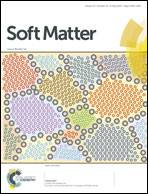Notch insensitive and self-healing PNIPAm–PAM–clay nanocomposite hydrogels†
Abstract
In the present work, hydrophilic monomer acrylamide (AM) was copolymerized with N-isopropylacrylamide (NIPAm) in an aqueous hectorite clay suspension to prepare PNIPAm–PAM–clay nanocomposite hydrogels (NC gels). With increasing AM content, the elongation at break of the copolymerized NC gels increased but the strength as well as the hysteresis during the loading–unloading cycle decreased, showing faster relaxation due to the more hydrophilic copolymer chains with the AM segments. The elongation at break of the copolymerized NC gels was independent of the notch length and notch type, while the fracture energy was greatly increased to 3000–5000 J m−2 from 700 J m−2 for the pure PNIPAm NC gels. The copolymer chains resulted in this notch insensitivity by easily dispersing the stress concentration at the notch tip through disorientation of the copolymer chains and clay platelets. The copolymerized NC gels also exhibited excellent self-healing capability; the cut surfaces were connected together by simply keeping in contact for a period of time (about 4 days at 20 °C). This self-healing was accelerated by increasing the treatment temperature (about 4 h at 80 °C).


 Please wait while we load your content...
Please wait while we load your content...